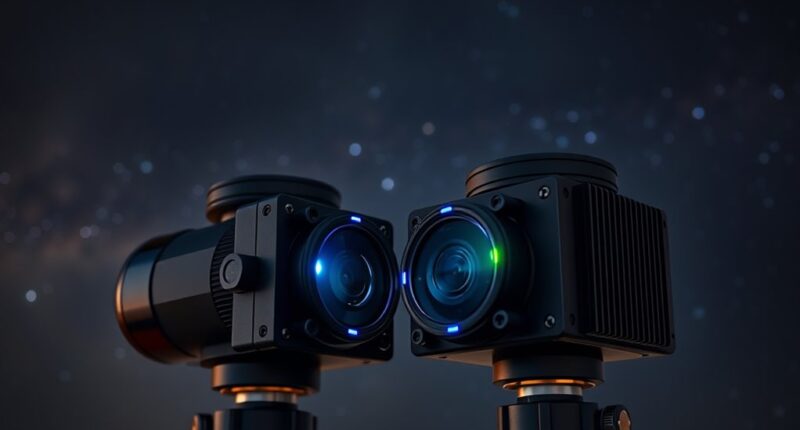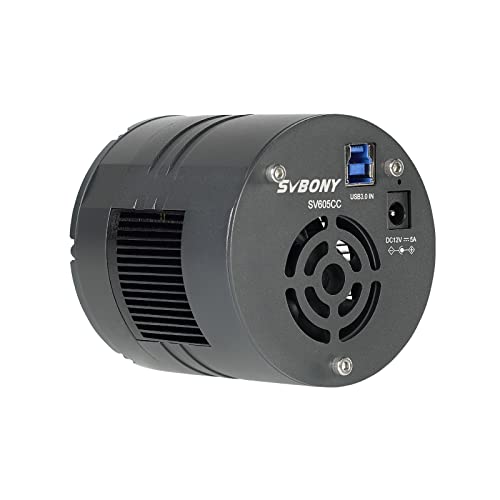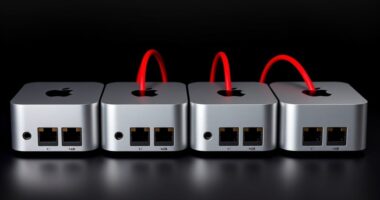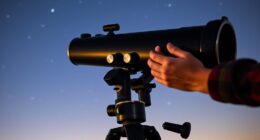If you’re looking for the best cooled CMOS astro cameras for deep sky imaging in 2025, I recommend the SVBONY SV605CC and Astromania SGCMOS series. The SV605CC offers high resolution and efficient TEC cooling, making it great for faint object capture, while the Astromania series provides reliable performance with user-friendly features. Both models balance sensitivity, stability, and affordability. Stay with me to explore more about their features and what to evaluate for stellar results.
Key Takeaways
- The SVBONY SV605CC offers high-resolution imaging with effective TEC cooling, ideal for detailed deep sky astrophotography.
- Both cameras provide user-friendly features like adjustable exposure, manual focus, and wide software compatibility for easy setup.
- Cooling systems in these models significantly reduce sensor noise, improving image quality during long exposures in 2025.
- They support multiple power sources and data ports, ensuring reliable operation in varied astrophotography setups.
- These models balance cost, durability, and performance, making them top choices for deep sky imaging enthusiasts in 2025.
SVBONY SV605CC Cooled Camera, 9MP CMOS Telescope Camera
If you’re looking for an affordable yet capable cooled CMOS astro camera, the SVBONY SV605CC stands out as a great choice. It features a 9MP IMX533 sensor with a 1-inch square chip, offering 3008×3008 resolution and 80% quantum efficiency, perfect for deep sky imaging. The camera’s TEC cooling system can drop sensor temperature to 30°C below ambient, ensuring stable images. Compatible with Windows, Linux, Mac, and even Raspberry Pi, it supports Wi-Fi, USB, and remote control. Its compact design and included accessories make it versatile for both beginners and experienced astrophotographers, delivering impressive results on a budget.
Best For: budget-conscious amateur astronomers and astrophotographers seeking an affordable cooled CMOS camera for deep sky imaging and planetary observation.
Pros:
- High-resolution 9MP IMX533 sensor with excellent quantum efficiency for detailed astrophotography
- Compact, lightweight design with versatile compatibility across Windows, Linux, Mac, and Raspberry Pi
- Effective TEC cooling system that reduces sensor temperature by up to 30°C below ambient for more stable images
Cons:
- Noisy cooling fan may interfere with outdoor use and impact long-term durability
- Inconsistent cooling performance and high noise levels can require additional calibration and post-processing
- Frame drops and image quality limitations compared to higher-end astro cameras may affect advanced imaging results
Astromania SGCMOS Series Telescope CMOS Camera
The Astromania SGCMOS Series Telescope CMOS Camera stands out as a solid choice for amateur astrophotographers seeking reliable guiding and imaging capabilities on a budget. It features a high-sensitivity sensor with fast frame rates and long exposure support, ideal for auto-guiding and deep sky imaging. Its aluminum CNC housing includes a 1.25-inch nosepiece for precise focusing and filter installation, plus a built-in ST4 guider port for easy guiding setup. Compatible with Linux, Windows, and Mac (with some limitations), it delivers decent performance for lunar, planetary, and guiding tasks. While driver issues can arise, especially on newer Windows OS, it remains a popular, affordable option for beginners and hobbyists.
Best For: amateur astrophotographers and hobbyists seeking an affordable, reliable guiding and imaging camera compatible with multiple operating systems.
Pros:
- Supports auto-guiding, deep sky imaging, and multicolor astrophotography with a high-sensitivity sensor.
- Made with durable aluminum CNC housing and includes a 1.25-inch nosepiece for precise focusing and filtering.
- Compatible with Linux, Windows, and Mac (though with some driver limitations), offering versatile connectivity options.
Cons:
- Driver signing and compatibility issues, especially on Windows 10/11, may require workarounds.
- Lower sensitivity compared to premium cameras like QHY or ZWO, necessitating longer exposure times.
- Limited lens options due to C-mount design unless spacers are used, and some users report driver crashes or instability.
Factors to Consider When Choosing Cooled CMOS Astro Cameras for Deep Sky Imaging

When selecting a cooled CMOS astro camera for deep sky imaging, I focus on cooling efficiency and stability to keep noise low. I also consider sensor sensitivity and resolution to capture detailed images, along with compatibility with my existing software and hardware. Finally, I check for ease of setup, operation, and how noise levels might impact overall image quality.
Cooling Efficiency and Stability
Choosing a cooled CMOS astro camera with efficient and stable cooling is crucial for achieving high-quality deep sky images. Effective cooling typically uses TEC systems that can lower sensor temperatures by at least 30°C below ambient, reducing thermal noise considerably. Stability is equally important; a camera must maintain a consistent temperature throughout long exposures to prevent fluctuations that cause noise, hot pixels, or artifacts. Proper thermal regulation involves solid insulation and heat dissipation mechanisms to counteract external environmental changes. Inconsistent cooling can lead to image degradation, increased noise, and artifacts like horizontal lines. Long exposure astrophotography especially benefits from stable cooling, as it minimizes sensor heat buildup, ensuring consistent performance and a better signal-to-noise ratio for stunning astrophotos.
Sensor Sensitivity and Resolution
Sensor sensitivity, measured by quantum efficiency (QE), plays an essential role in capturing faint deep-sky objects, as higher QE values—such as 80%—allow the camera to convert more incoming photons into measurable signals. This means better low-light performance and clearer images of dim nebulae and galaxies. Resolution, indicated by pixel count and size, influences the detail and sharpness of your images; larger pixel counts deliver more detail but may require longer exposures and more processing. Additionally, larger sensors like 1-inch or square chips provide a wider field of view and improved light-gathering capacity. Striking the right balance between sensitivity and resolution helps optimize imaging efficiency, yielding detailed, high-quality astrophotos without overwhelming your processing workflow.
Compatibility With Software and Hardware
Ensuring your cooled CMOS astro camera works smoothly with your existing setup is vital for efficient deep sky imaging. I always check that the camera supports popular software like SharpCap, PHD2, ASCOM, or INDI for seamless control. Compatibility across my operating system—Windows, Linux, or Mac—is essential to avoid connectivity issues. I verify that the drivers are regularly updated and compatible with the latest software versions, minimizing glitches. Hardware interfaces matter too; I confirm the camera’s USB type (2.0 or 3.0), Wi-Fi, or C-mount compatibility with my computer and mount control systems. Additionally, remote control options and firmware updates are beneficial for maintaining compatibility and improving user experience over time. Prioritizing these factors ensures a smooth, hassle-free imaging experience.
Noise Levels and Image Quality
When evaluating cooled CMOS astro cameras, understanding their noise performance and overall image quality is key to capturing detailed deep sky images. Higher noise levels, such as graininess or horizontal lines, can degrade image clarity, especially in dark frames. The sensor’s quantum efficiency and cooling stability directly impact noise reduction and the sharpness of deep sky objects. Inadequate cooling or inconsistent temperature control lead to thermal noise, diminishing contrast and detail. Effective noise suppression involves careful calibration, stacking, and post-processing, which can be time-consuming and may not fully eliminate artifacts. Ultimately, the balance between sensor sensitivity, exposure time, and noise levels determines how well a camera can produce high-quality astrophotos, making noise management a critical factor in choosing the right cooled CMOS camera.
Ease of Setup and Operation
Choosing a cooled CMOS astro camera that’s easy to set up and operate can make a significant difference, especially for beginners or those looking to streamline their workflow. Many models feature intuitive interfaces and compatible software, making the initial setup straightforward. Detailed manuals and adapters help connect the camera to your telescope and guiding equipment quickly, saving time and frustration. Integrated cooling systems, like TEC refrigeration, simplify thermal management by reducing the need for extra hardware. User-friendly features such as manual focus controls, adjustable exposure settings, and compatibility with popular astrophotography software further ease operation. Manufacturers often provide step-by-step installation guides and support resources, helping users configure their cameras efficiently and start capturing stunning deep-sky images with minimal hassle.
Power Supply and Port Options
Power supply and port options play a vital role in the reliability and convenience of cooled CMOS astro cameras, especially during long imaging sessions. Many models support multiple power inputs like DC adapters, USB power, or external battery packs, enhancing portability and flexibility. USB ports—whether USB 2.0 or 3.0—are common for data transfer and power, simplifying setup with just a single cable. Some cameras feature dedicated power ports or adapters to provide stable, uninterrupted power, essential for extended imaging. Compatibility with various port types such as USB-C, Micro USB, or USB-A can influence ease of connection with your computer and accessories. Ensuring these options align with your observational setup helps maintain reliable operation and minimizes disruptions, making your astrophotography experience smoother and more efficient.
Cost and Long-term Value
Investing in a cooled CMOS astro camera requires careful consideration of both initial costs and long-term value. Prices vary considerably—from budget models costing a few hundred dollars to premium options exceeding a thousand—impacting affordability over time. Choosing a camera with reliable cooling and stable performance can reduce the need for frequent replacements or upgrades, offering better long-term value. Durability of key components, like cooling elements and sensors, influences lifespan and ongoing maintenance costs, making some options more cost-effective. Compatibility with evolving software and hardware also extends usability, saving money on future upgrades. Ultimately, prioritizing image quality, noise suppression, and upgradeability ensures your initial investment continues to deliver stellar results as your skills and equipment needs grow.
Frequently Asked Questions
How Does Cooling Impact Image Noise in CMOS Astro Cameras?
Cooling considerably reduces image noise in CMOS astro cameras by lowering the sensor’s temperature, which decreases thermal noise generated during long exposures. When I cool my camera, I notice cleaner, more detailed images with less graininess, especially in deep sky shots. It helps me capture faint objects more clearly. Without cooling, noise can obscure subtle details, making it harder to achieve high-quality astrophotography results.
What Are the Best Software Options for Managing Cooled CMOS Cameras?
Did you know that over 60% of astrophotographers use dedicated software to manage their cooled CMOS cameras? I find SharpCap incredibly user-friendly for live stacking and camera control, making my imaging sessions smoother. Sequence Generator Pro is perfect for automating captures, while PHD2 helps with guiding. These tools streamline workflows, reduce noise, and maximize image quality, so I can focus on capturing stunning deep-sky images with confidence.
How Compatible Are These Cameras With Various Telescope Mounts?
I find that most cooled CMOS astro cameras are highly compatible with a wide range of telescope mounts, especially those supporting standard interfaces like USB, ASCOM, or ST4 guiding ports. I always double-check the camera’s specifications and the mount’s compatibility list before purchasing. In my experience, with the right adapters and software, you can seamlessly integrate these cameras with most popular mounts, ensuring smooth imaging sessions.
What Is the Typical Lifespan of Cooled CMOS Astro Cameras?
Cooled CMOS astro cameras typically last around 3 to 5 years, but with proper care, they can serve even longer. Think of them as celestial vessels that weather many cosmic storms—calmly enduring through time. Regular cleaning, gentle handling, and firmware updates are like fueling their journey, ensuring they continue capturing starlight vividly. So, while their lifespan varies, diligent maintenance keeps your astrophotography voyage bright and enduring.
Can Cooled CMOS Cameras Be Used Effectively for Planetary Imaging?
Absolutely, cooled CMOS cameras work great for planetary imaging. Their high frame rates and low noise make capturing fine details easier, especially during short, high-quality video sessions. Cooling helps reduce thermal noise, ensuring clearer images. I’ve used them successfully for planets like Jupiter and Saturn, and the results are impressive. They’re versatile tools, suited for both deep-sky and planetary work, making them a smart choice for enthusiasts and professionals alike.
Conclusion
Choosing the right cooled CMOS astro camera is like selecting a trusted compass for your night sky voyage. With the SVBONY SV605CC and Astromania SGCMOS series, you’re equipping yourself with reliable guides that illuminate your deep sky adventures. Remember, the right gear doesn’t just lead you to stunning images but transforms your stargazing journey into an unforgettable voyage of discovery. So, pick your navigator wisely and let the stars reveal their secrets.











